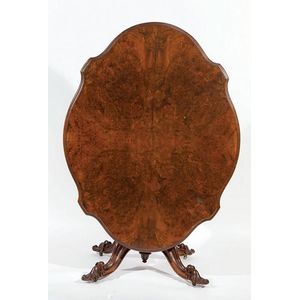Victorian Burled Walnut Breakfast Table with Floral Marquetry
You must be a subscriber, and be logged in to view price and dealer details.
Subscribe Now to view actual auction price for this item
When you subscribe, you have the option of setting the currency in which to display prices to $Au, $US, $NZ or Stg.
- Veneers - Veneers are thin sheets of well-figured timber that are glued under pressure to the surface of a cheaper timber for decorative effect, and then used in the making of carcase furniture.
Early veneers were saw-cut so were relatively thick, (up to 2 mm) but is was realised that saw cutting was wasteful, as timber to the equivilent of the thickness of the saw was lot on each cut.
A more efficient method was devised to slice the timber, either horizontally with a knife, or in a rotary lathe.
Flame veneer, commonly found in mahogany or cedar furniture, is cut from the junction of the branches and main trunk. So-called fiddleback veneers, where the grain is crossed by a series of pronounced darker lines, is usually cut from the outer sections of the tree trunk.
During the 17th and 18th centuries, and in much of the walnut marquetry furniture made during the latter part of the 19th century, the veneer was laid in quarters, each of the same grain, so that one half of the surface was the mirror image of the other.
The use of veneer allows many other decorative effects to be employed, including stringing, feather banding, cross banding, and inlaid decorative panels in the piece. The carcase over which veneer is laid is usually of cheaper timber such as pine, oak or, sometimes in Australia during the first half of the 19th century, red cedar.
The important thing to remember about veneers is that prior to about 1850 they were cut by hand, and were consequently quite thick - ranging up to about 2mm deep.
From the mid-19th century veneers were cut by machines and were almost wafer-thin. This is a critical point when trying to judge the approximate age of veneered furniture. - Victorian Period - The Victorian period of furniture and decorative arts design covers the reign of Queen Victoria from 1837 to 1901. There was not one dominant style of furniture in the Victorian period. Designers used and modified many historical styles such as Gothic, Tudor, Elizabethan, English Rococo, Neoclassical and others, although use of some styles, such as English Rococo and Gothic tended to dominate the furniture manufacture of the period.
The Victorian period was preceded by the Regency and William IV periods, and followed by the Edwardian period, named for Edward VII (1841 ? 1910) who was King of the United Kingdom and the British Dominions and Emperor of India for the brief period from 1901 until his death in 1910. - Quarter Veneer - In preparation for production of quarter-sawn veneer, the log is first quartered, meaning it's cut into four equal quarters. Each quarter of the log is then cut radially, resulting in boards with annual growth rings at approximately 90 degrees to the face of the board. Veneer Cutting: These boards are then sliced into thin veneer sheets using a veneer slicer. Quarter-sawn wood is known for its unique and attractive appearance and the growth rings have a distinctive figuring often referred to as ray fleck or medullary ray.
Quarter-sawn veneer is commonly used in furniture making. The unique grain pattern adds aesthetic appeal to pieces like cabinets, tables, and chairs. Decorative Panels: It is also used in the production of decorative panels for interior applications, such as wall panelling, doors, and trim. Some musical instrument makers use quarter-sawn veneer for the back and sides of instruments like guitars, providing both visual appeal and stability.
The distinctive grain pattern adds a unique and desirable look to finished products. Quarter-sawn wood, and consequently quarter-sawn veneer, can be more expensive than other types of wood due to the cutting process - Burr - Burr (or in the USA, burl) is the timber from the knotted roots or deformed branch of the tree, which when cut, displays the small circular knots in various gradations of colour. It is always cut into a decorative veneer, most commonly seen as burr walnut on 19th century furniture.
- Marquetry - In marquetry inlay, contrasting woods, and other materials such as ivory, shell and metal are inlaid either as panels or in a single continuous sheet over the surface of the piece. The design may be straightforward, such as a shell pattern or a basket of flowers, or it may be infinitely complex, with swirling tendrils of leaves, flowers and foliage, such as one finds, for example, in the "seaweed" patterns on longcase clocks of the William and Mary and Queen Anne periods.
This item has been included into following indexes:
Visually similar items

A good Victorian walnut loo table with shaped top and birdcage base. Height 73 cm. Width 148 cm. Depth 106 cm

Victorian burr walnut snap top loo table of quatrefoil outline on tapering reeded baluster column and four scroll moulded legs

Silver plate reticulated gallery tray with foliate engravings

An old wooden platter, on purpose built stand, used to present cone shells (new mwali) to Kaileuna Chiefs at end of the communal cone fishing competiton Vinau, purchased from Chief Katubai on Kaileuna Island, Trobriand Islands Papua New Guinea, mentioned i
